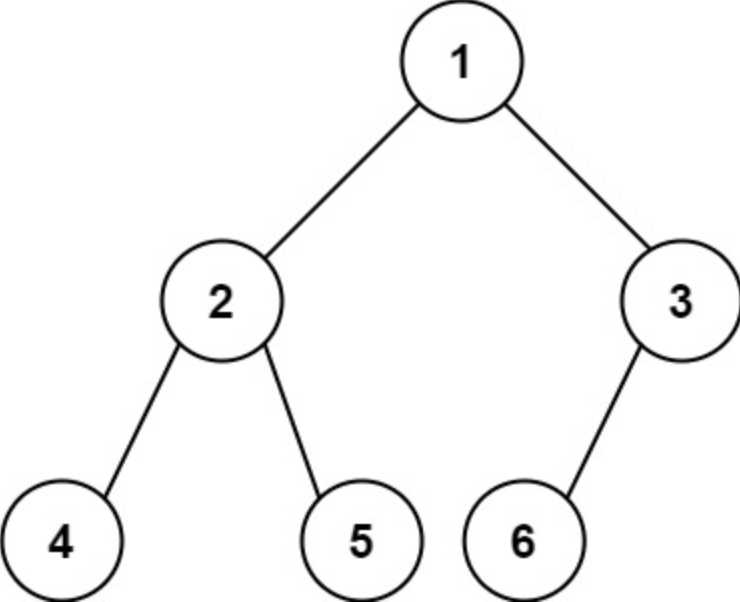104. 二叉树的最大深度
leetcode链接:力扣题目链接(opens new window)
视频链接:二叉树的高度和深度有啥区别?究竟用什么遍历顺序?很多录友搞不懂 | 104.二叉树的最大深度 (opens new window)
给定一个二叉树,找出其最大深度。
二叉树的深度为根节点到最远叶子节点的最长路径上的节点数。
说明: 叶子节点是指没有子节点的节点。
示例:
给定二叉树 [3,9,20,null,null,15,7],
3
/ \
9 20
/ \
15 7
返回它的最大深度 3
经历了昨天的层次遍历,这道题在之前也做过,有两种方法。递归法(前/后序遍历)和迭代法(层次遍历)
这里需要注意的是:
- 深度(后序遍历) :当前节点到根节点的距离;
- 高度(前序遍历):当前节点到叶子节点的距离。
递归法(分解法)
根节点的高度就是二叉树的最大深度。
- 确定递归函数的参数和返回值
参数就是传入树的根节点,返回就返回这棵树的深度,所以返回值为int类型:
int getdepth(TreeNode* node)
- 确定终止条件
如果为空节点的话,就返回0,表示高度为0。
if (node == NULL) return 0;
- 确定单层递归逻辑
先求它的左子树的深度,再求右子树的深度,最后取左右深度最大的数值 再+1 (加1是因为算上当前中间节点)就是目前节点为根节点的树的深度。
int leftdepth = getdepth(node->left); // 左
int rightdepth = getdepth(node->right); // 右
int depth = 1 + max(leftdepth, rightdepth); // 中
return depth;
总的代码:
class Solution {
public:
int maxDepth(TreeNode* root) {
if (root == nullptr) {
return 0;
}
// 利用定义,计算左右子树的最大深度
int leftMax = maxDepth(root->left);
int rightMax = maxDepth(root->right);
// 整棵树的最大深度等于左右子树的最大深度取最大值,
// 然后再加上根节点自己
//这个属于后序遍历
int res = max(leftMax, rightMax) + 1;
return res;
}
};
迭代法(层次遍历)
class Solution {
public:
int maxDepth(TreeNode *root) {
queue<TreeNode *> q;
int depth = 0;
if (root == nullptr) {
return depth;
}
q.push(root);
while (!q.empty()) {
depth++;
unsigned int sz = q.size();
for (int i = 0; i < sz; i++) {
TreeNode *cur = q.front();
q.pop();
if (cur->left != nullptr) {
q.push(cur->left);
}
if (cur->right != nullptr) {
q.push(cur->right);
}
}
}
return depth;
}
};
559.N叉树的最大深度
同理,也可以用递归法和迭代法。只需要修改几行代码
递归法
修改遍历的左右子树改成for:
class Solution {
public:
int maxDepth(Node* root) {
if(root == nullptr){
return 0;
}
int depth = 0;
for(auto child : root->children){
depth = max(depth, maxDepth(child)) ;
}
return depth + 1;
}
}
迭代法
入队的时候左右子树改成for:
class Solution {
public:
int maxDepth(Node* root) {
queue<Node *> q;
int depth = 0;
if (root == nullptr) {
return depth;
}
q.push(root);
while (!q.empty()) {
depth++;
unsigned int sz = q.size();
for (int i = 0; i < sz; i++) {
Node *cur = q.front();
q.pop();
for(auto child: cur->children){
if(child != nullptr){
q.push(child);
}
}
}
}
return depth;
}
};
111. 二叉树的最小深度
求最小,适合用层序遍历BFS来解,当节点的左右子树都为空时,说明是叶子节点,就最早找到最小深度了:
class Solution {
public:
int minDepth(TreeNode* root) {
queue<TreeNode*> q;
int depth = 0;
if(root == nullptr){
return depth;
}
q.push(root);
while(!q.empty()){
depth++;
unsigned int sz = q.size();
for(int i = 0; i < sz; i++) {
TreeNode *cur = q.front();
q.pop();
if (cur->left == nullptr && cur->right == nullptr) {
return depth;
}
if (cur->left != nullptr) {
q.push(cur->left);
}
if (cur->right != nullptr) {
q.push(cur->right);
}
}
}
return depth;
}
};
递归法
class Solution {
public:
int minDepth(TreeNode* root) {
if(root == nullptr){
return 0;
}
int leftMin = minDepth(root->left);
int rightMin = minDepth(root->right);
if(root->left == nullptr && root->right != nullptr){
return 1 + rightMin;
}
if(root->right == nullptr && root->left != nullptr){
return 1 + leftMin;
}
//陷阱:不能直接从max改成min,考虑有一方全部为空的情况,形状像链状的二叉树
return min(leftMin,rightMin) + 1;
}
};
222. 完全二叉树的节点个数
leetcode链接:力扣题目链接
视频链接:要理解普通二叉树和完全二叉树的区别! | LeetCode:222.完全二叉树节点的数量 (opens new window)
给你一棵 完全二叉树 的根节点 root ,求出该树的节点个数。
完全二叉树 的定义如下:在完全二叉树中,除了最底层节点可能没填满外,其余每层节点数都达到最大值,并且最下面一层的节点都集中在该层最左边的若干位置。若最底层为第 h 层,则该层包含 1~ 2h 个节点。
示例 1:
输入:root = [1,2,3,4,5,6]
输出:6
示例 2:
输入:root = []
输出:0
示例 3:
输入:root = [1]
输出:1

首先我的思路是用层序遍历,每次元素出队时count++,因为每个元素只会出队一次。感觉适合所有的二叉树:
class Solution {
public:
int countNodes(TreeNode* root) {
queue<TreeNode*> q;
int count = 0;
if(root == nullptr){
return count;
}
q.push(root);
while(!q.empty()){
unsigned int sz = q.size();
for(int i = 0; i < sz; i++){
TreeNode* cur = q.front();
q.pop();
count++;
if(cur->left != nullptr){
q.push(cur->left);
}
if(cur->right != nullptr) {
q.push(cur->right);
}
}
}
return count;
}
};
最后确实是通过了,但没有利用好完全二叉树的条件,是否有更巧妙的方法?
是有的!
完全二叉树只有两种情况:
- 情况一:就是满二叉树
- 情况二:最后一层叶子节点没有满。
对于情况一,可以直接用 2^树深度 - 1 来计算,注意这里根节点深度为1。
对于情况二,分别递归左孩子,和右孩子,递归到某一深度一定会有左孩子或者右孩子为满二叉树,然后依然可以按照情况1来计算。
判断其子树是不是满二叉树,如果是则利用公式计算这个子树(满二叉树)的节点数量,如果不是则继续递归,那么 在递归三部曲中,第二部:终止条件的写法应该是这样的:
if (root == nullptr) return 0;
// 开始根据左深度和右深度是否相同来判断该子树是不是满二叉树
TreeNode* left = root->left;
TreeNode* right = root->right;
int leftDepth = 0, rightDepth = 0; // 这里初始为0是有目的的,为了下面求指数方便
while (left) { // 求左子树深度
left = left->left;
leftDepth++;
}
while (right) { // 求右子树深度
right = right->right;
rightDepth++;
}
if (leftDepth == rightDepth) {
return (2 << leftDepth) - 1; // 注意(2<<1) 相当于2^2,返回满足满二叉树的子树节点数量
}
递归三部曲,第三部,单层递归的逻辑:(可以看出使用后序遍历)
int leftTreeNum = countNodes(root->left); // 左
int rightTreeNum = countNodes(root->right); // 右
int result = leftTreeNum + rightTreeNum + 1; // 中
return result;
可以得到最终的代码:
class Solution {
public:
int countNodes(TreeNode* root) {
if (root == nullptr) return 0;
TreeNode* left = root->left;
TreeNode* right = root->right;
int leftDepth = 0, rightDepth = 0; // 这里初始为0是有目的的,为了下面求指数方便
while (left) { // 求左子树深度
left = left->left;
leftDepth++;
}
while (right) { // 求右子树深度
right = right->right;
rightDepth++;
}
if (leftDepth == rightDepth) {
return (2 << leftDepth) - 1; // 注意(2<<1) 相当于2^2,所以leftDepth初始为0
}
return countNodes(root->left) + countNodes(root->right) + 1;
}
};
总结
迭代算法适合BFS求最小最短,递归代码简洁,但比较抽象,希望可以好好锻炼递归思维。























 被折叠的 条评论
为什么被折叠?
被折叠的 条评论
为什么被折叠?








